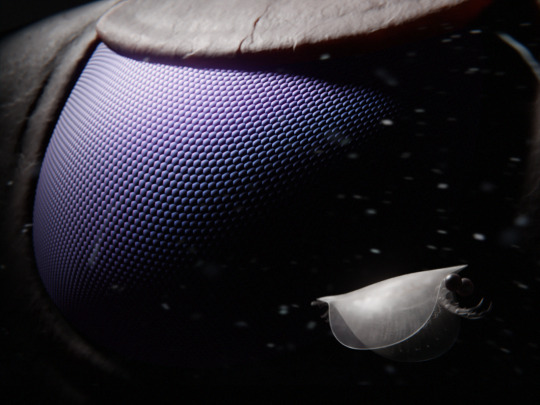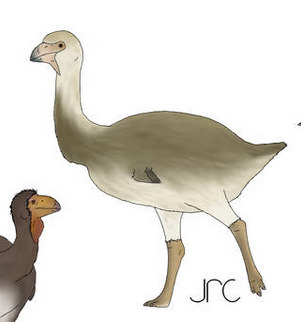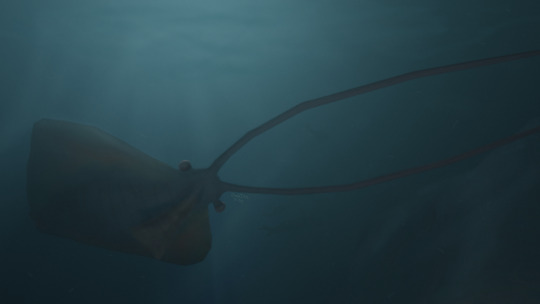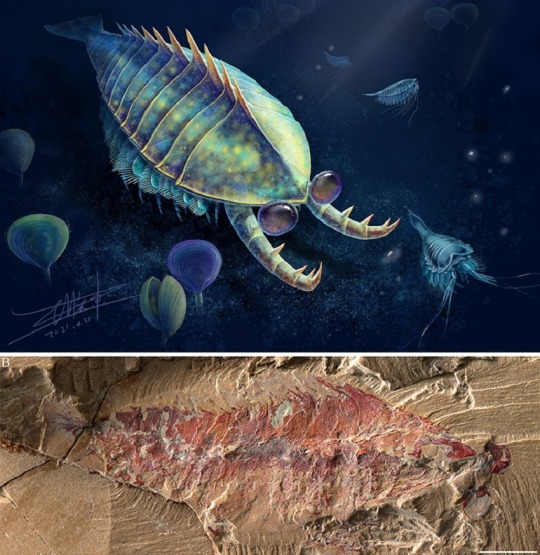#isoxys
Text

514 millions years ago in what will one day be known as the Emu Bay Shale (South Australia), a tiny Isoxys glaessneri encounters the hunter 'Anomalocaris' briggsi.
'Anomalocaris' briggsi was a large suspension-feeding radiodont related to the famous raptorial predator Anomalocaris canadensis. It is one of two radiodont species for which exceptionally detailed fossils of compound eyes are known. The eyes in this species are unsual for radiodonts in that they are not stalked, and protected by a small plate which was likely a modified version of the lateral carapace elements found in hurdiids. The eye morphology suggests that 'A.' briggsi was a mesopelagic species capable of inhabiting depths of several hundred meters, using its acute vision to detect planktonic prey (Paterson et al. 2020).
Isoxys was a cosmopolitan genus of stem-euarthropod in the Lower and Middle Cambrian, characterized by a bivalved shield covering its whole body, two large eyes, and a frontal pair of so-called 'great appendages' probably used for grasping food items. These appendages show similarity with both the frontal appendages of megacheirans and those of radiodonts like Anomalocaris, and its mix of derived and basal anatomical traits (such as biramous appendages but an unclerotized trunk) make it a crucial organism for understanding the early evolution of arthropods (Legg & Vannier 2013, Zhang et al. 2021).
I tried to recreate the feeling of this common yet lovely type of scene in sci-fi movies where a ship or station gets dwarfed by a gigantic object slowly emerging behind it from the shadows - the only difference is that the 'giant' eye here is only about 3 cm wide, though that was still huge for the time.
References and technical details about the reconstruction under the cut:
The soft parts of I. glaessneri are not known (except for the eyes). Trunk appendages are based on I. curvirostratus (Zhang et al. 2021). Great appendages are partially based on I. communis, which may be the adult form of I. glaessneri (Fu et al. 2012); unfortunately, the great appendages of I. communis are poorly preserved (García-Bellido et al. 2009), so frontal appendage morphology was complemented with the better-known I. acutangulus.
The Isoxys is depicted here with only 11 pairs of trunk limbs, instead of the usual 13+ (Zhang et al. 2021). Based on the assumption that the ancestral arthropod grew by post-hatching addition of segments (anamorphosis) (Liu et al. 2016), a reduced number of trunk limbs was judged appropriate given the small size of the specimen (ca. 6.5 mm) and the possible juvenile nature of I. 'glaessneri'.
References:
Fu, D., Zhang, X., Budd, G. E., Liu, W., & Pan, X. (2014). Ontogeny and dimorphism of Isoxys auritus (Arthropoda) from the Early Cambrian Chengjiang biota, South China. Gondwana Research, 25(3), 975–982. https://doi.org/10.1016/j.gr.2013.06.007
García-Bellido, D. C., Paterson, J. R., Edgecombe, G. D., Jago, J. B., Gehling, J. G., & Lee, M. S. Y. (2009). The bivalved arthropods Isoxys and Tuzoia with soft-part preservation from the Lower Cambrian Emu Bay Shale Lagerstätte (Kangaroo Island, Australia). Palaeontology, 52(6), 1221–1241. https://doi.org/10.1111/j.1475-4983.2009.00914.x
Legg, D. A., & Vannier, J. (2013). The affinities of the cosmopolitan arthropod Isoxys and its implications for the origin of arthropods. Lethaia, 46(4), 540–550. https://doi.org/10.1111/let.12032
Liu, Y., Melzer, R., Haug, J., Haug, C., Briggs, D., Hörnig, M., He, Y., & Hou, X. (2016). Three-dimensionally preserved minute larva of a great-appendage arthropod from the early Cambrian Chengjiang biota. Proceedings of the National Academy of Sciences, 113, 5542–5546. https://doi.org/10.1073/pnas.1522899113
Paterson, J. R., Edgecombe, G. D., & García-Bellido, D. C. (2020). Disparate compound eyes of Cambrian radiodonts reveal their developmental growth mode and diverse visual ecology. Science Advances, 6(49), eabc6721. https://doi.org/10.1126/sciadv.abc6721
Schoenemann, B., & Clarkson, E. N. k. (2011). Eyes and vision in the Chengjiang arthropod Isoxys indicating adaptation to habitat. Lethaia, 44(2), 223–230. https://doi.org/10.1111/j.1502-3931.2010.00239.x
Zhang, C., Liu, Y., Ortega-Hernández, J., Wolfe, J. M., Jin, C., Mai, H., Hou, X. G., Guo, J., & Zhai, D. (2021). Differentiated appendages in Isoxys illuminate origin of arthropodization. Research Square.
#anomalocaris#radiodont#isoxys#arthropod#eyes#compound eye#pelagic#emu bay shale#cambrian#paleozoic#paleoart#my art
485 notes
·
View notes
Text
Links in lieu of propoganda
Ilbandornis, a cenozoic dromornithid bird

Inoceramus, a mesozoic giant bivalve

Isisfordia, a cretaceous crocodile

Isoxys, a cambrian bivalved arthropod

#please reblog#feel free to advocate for your favourite#palaeoblr#australian fossil alphabet thing#megafauna#ilbandornis#inoceramus#isisfordia#isoxys
28 notes
·
View notes
Text
Nectocaris pteryx, a relativity famous10 centimeter long creature from the Burgess shale formation. Being an active predator, It would have likely eaten soft-bodied swimming animals like isoxys and Metaspriggina.

Although it's taxonomic grouping has been up to some debate, the resemblance between the recently described Timorebestia and other nectocaridids such as petalilium leads me to believe that nectocaridids could stem-group chaetognaths.
(A proper study is required to confirm this!)
43 notes
·
View notes
Text
Cambrian Dashboard Simulator: obscure lads!
🥔 nonvermiform
Does anyone else here enjoy some nice silt every now and again?
🫂 embracingbeast Follow
literally nobody cares about you and your fellow mud-eaters, Saccorhytus
swedish_cyclopsdeactivated1003065012
I’ll have you know that anti-meiofaunal speech like that is incredibly nicheist. What’s he supposed to do about it, suddenly grow to as big as an Isoxys?
🦞 shrimp_from_oland Follow
I second that. As a fellow sediment-feeder myself, I can confirm swedish_cyclops’s views are true.
🗡️ laminatedlad Follow
bro wtf are you gonna do you’re like 1 mm long
48,194 notes
🔦 alightinthedark
🪛 chaetognatha_stem Follow
Me obviously, I eat isoxyids for breakfast. I’m also twice the size of @proclamation_claw.
🦂 omnidens_worshipper
You do realise your phylum is dying out, right? Plus, I’m bigger than you and don’t even bother with the isoxyids.
21,947 notes
🪳just_mosiing_along

me when I have the entirety of the beach to myself
🐟fishfromhaikou Follow
you’re lucky to have such a good life. i have to worry about radiodonts eating me or getting washed up on the shore and left to people like you
3,710 notes
🌲petalonamae_fan Follow
bro what happened in the last 40 million years I swear the Ediacaran was yesterday
🌊 beforejawswerecool
did you accidentally settle onto those paucipodia brownies @incertae_sedis made?
because I don’t think 40 million years of memory loss is normal.
🪶 wonderfulfeather Follow
t h e y t o l d m e a p r o p h e c y
8,158 notes
🥕not_a_spiralian Follow
reblog if you hate lobopodians
278 notes
🪸 the_king_omnidens
hey
#lobopodia #pambdeluriidae #maotianshan reef
291,481 notes
👻 phantomofruinwash
it feels nice to finally be described as Mobulavermis adustus. I’ve also finally gotten a fossil with a preserved head!
🦀shu’s_shrimp Follow
speak for yourself. i’ve barely been mentioned in the literature and only have an abstract available.
🇷🇺 kuonamka_tardigrade
you guys have scientific names?
#kuonamkaformation #tardigrade
1,974 notes
🧢meio_beret
hey @nonvermiform, how are you doing? it’s always nice to see you again with no company on the Yanjiahe seafloor but the weird stalked things.
🥔 nonvermiform
Doing alright. Although there were some radiodonts that tried to get a sifter to eat me.
🐋romip65415 Follow
still gonna eat you, @nonvermiform
28,193 notes
(this is for you @ravewing)
#cambrian#anomalocaris#mobulavermis#lobopodia#radiodont#chaetognatha#anomalopost#dashboard simulator
14 notes
·
View notes
Text
62 notes
·
View notes
Text
51 notes
·
View notes
Photo

A new euarthropod with large frontal appendages from the early Cambrian Chengjiang biota
Robert J. O’Flynn, Mark Williams, Mengxiao Yu, Thomas H.P. Harvey, and Yu Liu
ABSTRACT
We describe Fengzhengia mamingae gen. et sp. nov., a new euarthropod from the lower Cambrian (Series 2, Stage 3) Chengjiang Lagerstätte, Southwest China.
Fengzhengia mamingae possesses prominent frontal appendages, stalked, circular eyes, a simple, sub-triangular head shield, and a trunk with 15 tergites, the anterior nine each bearing a single medial axial spine. Limited evidence suggests biramous trunk appendages with paddle-shaped exopods. At the posterior end is a sub-triangular region, possibly a pygidium, articulated with a tail fan.
The frontal appendage of F. mamingae resembles those of certain ‘great appendage’ arthropods and Isoxys. We test the affinities of F. mamingae by parsimony and Bayesian analyses and tentatively suggest that it is an early branch of Deuteropoda.
We suggest that F. mamingae may have been a nektobenthic scavenger or predator, and its dorsal exoskeleton is notable for exhibiting defensive spines.
Read the paper here:
https://palaeo-electronica.org/content/2022/3551-a-new-chengjiang-euarthropod
50 notes
·
View notes
Text
Mermay Prompts (Unofficial)- Prehistoric Edition
Anomalocaris
Trilobite
Megalodon
Essexella
Dunkleosteus
Ammonite
Icthyosaur
Plesiosaur
Cameroceras
Opabinia
Tamisiocaris borealis
Hurdia victoria
Hallucigenia
Wiwaxia
Ottoia prolifica
Haplophrentis carinatus
Isoxys
Marrella
Leanchoilia
Dickinsonia
Syllipsimopodi bideni
Styletoctopus
Tusoteuthis
Priscomyzon riniensis
Asterotrygon maloneyi
Glyphithyreus
Leedsichthys
Tylosaurus
Metriorhynchus
Kronosaurus
Prehistoric hominid (Reverse Mermaid!)
The last prompt is a bit of a wild card, with the human side being prehistoric as well as the fish.
(I personally will not be able to post every day, but I intend to fill all 31 prompts).
This is not intended to be scientific, more of an exploration of sea creature art, and the extinct sealife I see getting passed over in most MerMays. I'll still be making traditional mermaid art for most of these (with a twist). I hope you enjoy.
8 notes
·
View notes
Note
Sometime when you have the energy, I'd love to hear your essay on the Cambrian Explosion and invention 👀
Yes!! Absolutely. It would be my delight.
So it’s the beginning of the Paleozoic era. What has it taken to get to this point? God has been busy, but it’s slow going. He's formed earth, moon, and oceans. The earth has a granite crust. Life has emerged under His careful hand: unimaginable numbers of molecular combinations have been thrown together across trillions of mineral surfaces over the course of many millions of years and yielded the first functional, crudely self-replicating molecular system, whether it was the citric acid cycle, or an autocatylitic network, or self-replicating RNA. And it worked. It began to propagate and evolve, and that invention has grown into cells, which formed endosymbiotic relationships, and now there are simple algaes and primitive sponges and biofilms. The beautiful, clever rubisco protein has emerged and pioneering cyanobacteria have used it to drive the Great Oxygenation Event. The earth’s surface has turned rust-red (like Mars), and along the edges of the continents green has begun to appear. Red against green against blue; the earth is poised.
God had patiently facilitated all of this slow, painstaking progress over the eons with an endpoint in mind. He’s nudged the right proteins together in the right places, caused the sun to shine and sustained those first primitive cells to survive long enough to reproduce, all with the full knowledge of where creation is going. He isn't in a hurry. Yet here, poised at the beginning of the Cambrian, I picture God rubbing His hands together in glee and saying to/within Himself, “Alright. Now for the fun part.”
Oxygen means that suddenly, there’s enough energy for animal life to thrive. An evolutionary arms race ensues, and here God’s inventiveness becomes wildly self-indulgent. He has laid a foundation. Now He plays. He invents predators and prey and he wraps them in hard armoured shells of larger and larger dimensions. He crafts bony plates and spines and sharp tails. Eyes begin to open and when they do, they see a world teeming with endless forms most beautiful. Creatures bite with teeth and scratch with claws.
The resulting creatures are strange-looking to the modern eye: Striated clams and delicate, fanlike bryozoa. Porous sponges and horn-shaped coral. Seven-eyed isoxys, three-foot almost-shrimp, and proto-arthropods with their long snoot-snoot noses. Trilobites, beautiful trilobites, leggy and wide-eyed and infinitely diverse. And somewhere, in the midst of all that beautiful, self-indulgent invention, God creates the first chordates.
Nearly all of the major animal phyla emerged during the Cambrian, of course, but the God of the Bible is ruthlessly focused on His greatest creation, the one that will bear His image. He’s building towards Homo sapiens, a creature that can glorify and enjoy Him forever, and so I think when those first chordates emerged, God must have rejoiced at His creation, the sound of “it is very good” reverberating recursively through eternity.
You see, for all the wild, self-indulgent playfulness of the Cambrian, God has always known what He is doing. He invented and He played and it was glorious, but in the fossils of those first chordates, I see Christ resurrected, and even further, the glorified bodies of every tribe, tongue, and nation, finally made perfect.
Where were you when I laid the foundation of the earth? Tell me, if you have understanding.
#thank you thank you thank you for this question#this is my favorite subject in case you couldn't tell#i will gush about God's evolutionary inventiveness all the live-long day#all truth is god's truth#ask me hard questions#pontifications and creations#endless forms most beautiful
20 notes
·
View notes
Note
2, 15, 21 for the end of year asks!
2. favourite fics of the year
I refuse to pick one, so I will simply pick a few without repeating fandoms!
then and now by @ziskandra
Fandom: Dragon Age
Relationships: Flemeth & Morrigan
Summary: A crow flapping its wings in the Korcari Wilds aids the defeat of a corrupted Tevinter magister in Orlais.
The Witches' Tale by Gheyn
Fandom: Cinderella is Dead
Relationships: Sophia Grimmins & Luke Langley + background Constance/Sophia
Summary: Sophia was fifty-one years old the first time she traveled back in time.
Five years passed in a gilded cage. Another ten she spent on the run. Twenty quiet years more while she gathered the skill and the power to turn back time, and this is where her tale begins anew.
Honey by @life-jim-but-not-as-we-know-it
Fandom: Star Wars: Thrawn Series (2017)
Relationships: Thrawn/Eli Vanto
Summary: Eli and Thrawn successfully resist the urges unleashed on them by alien sex pollen.
...but then they fuck anyway.
As The Gowans Grow Gay by isoxys
Fandom: The Darkest Part of the Forest
Relationships: Ben Evans/Severin
Summary: Getting used to life in the fae court, Ben still has some hangups about his musical gifts. Severin finds a kinky way to help him work through them.
Masks, Disguises, and Secrets - Oh My! by baka_tsumibito
Fandom: The Great Ace Attorney Chronicles
Relationships: Herlock Sholmes/Mikotoba Yuujin + Barok van Zieks & Iris Wilson
Summary: Sholmes and Mikotoba venture out to a ball; meanwhile, Iris has her own plans in mind.
15. favourite headcanon of the year
A little while ago I'd have said Meredith being fully conscious as a red lyrium statue but, well, you know. Instead I'll go with a semi-related headcanon that Samson lives 👀
21. favourite ship of the year
Meresino!
2 notes
·
View notes
Text
Ces vers prédateurs "géants", qui vivaient dans les eaux du Groenland il y a 518 millions d'années, dominaient les océans avant que les arthropodes ne prennent leur essor
See on Scoop.it - EntomoNews
... Nous savions jusqu’à présent que des arthropodes primitifs étaient les prédateurs dominants du Cambrien, comme les anomalocaridés à l’allure bizarre. Toutefois, Timorebestia est un parent éloigné, mais proche, des vers sagittaires vivants, ou chétognathes. Il s’agit aujourd’hui de prédateurs océaniques beaucoup plus petits qui se nourrissent de minuscules zooplanctons.
Guru Med | 6 Jan 2024
"Les fossiles, découverts dans le dépôt sédimentaire de Sirius Passet du Cambrien, au nord du Groenland, ont révélé que le Timorebestia possédait également des nageoires sur les flancs de son corps, une imposante mâchoire à l’intérieur de sa bouche et de longues antennes. Bien que sa longueur de 30 cm ne corresponde pas au nom de « bête de terreur » donné au ver, Timorebestia aurait été, à l’époque, l’un des plus grands nageurs.
Toujours selon Vinther :
Nos recherches montrent que ces anciens écosystèmes océaniques étaient assez complexes, avec une chaîne alimentaire qui permettait plusieurs niveaux de prédateurs. Les timorebestia étaient des géants de leur époque et auraient été proches du sommet de la chaîne alimentaire. Son importance est donc équivalente à celle de certains des principaux carnivores des océans modernes, tels que les requins et les phoques du Cambrien.
Le système digestif fossilisé a fourni aux chercheurs des indices sur le régime alimentaire du ver, des restes d’un arthropode nageur, le bivalve disparu Isoxys, ayant été identifiés.
Selon Morten Lunde Nielsen, ancien chercheur à l’université de Bristol et participant à l’étude :
Nous pouvons voir que ces arthropodes étaient une source de nourriture pour de nombreux autres animaux. Ils sont très communs à Sirius Passet et possèdent de longues épines protectrices, dirigées vers l’avant et vers l’arrière. Cependant, il est clair qu’ils n’ont pas complètement réussi à éviter ce destin, car Timorebestia les a dévorés en grande quantité.
Leur plus proche parent vivant, les chétognathes (ou vers sagittaires), mesurent généralement moins de 1 cm de long et se nourrissent de minuscules zooplanctons.
A partir de l’étude : reconstruction montrant l’anatomie interne et externe (rouge, musculature ; bleu, ganglion ventral ; noir, appareil maxillaire ; vert, intestin). (Tae-Yoon S. Park et col./ Science Advances)
Selon Vinther :
Les vers sagittaires et les Timorebestia, plus primitifs, étaient des prédateurs nageurs. Nous pouvons donc supposer que, selon toute vraisemblance, ils étaient les prédateurs qui dominaient les océans avant que les arthropodes ne prennent leur essor. Ils ont peut-être connu une dynastie d’environ 10 à 15 millions d’années avant d’être supplantés par d’autres groupes plus performants."
(...)
L’étude publiée dans Science Advances : A giant stem-group chaetognath et présentée sur le site de l’Université de Bristol : ‘Giant’ predator worms more than half a billion years old discovered in North Greenland.
Bernadette Cassel's insight:
https://www.scoop.it/search?q=+anomalocarid%C3%A9s
0 notes
Photo

Cambrian Explosion #44: Isoxyida
Isoxyids were a group of small and somewhat enigmatic panarthropods found all around the world's oceans during the mid-Cambrian, dating to between about 518 and 504 million years ago.
Their most distinctive feature was the large semi-circular carapace covering their bodies, with some species also having long defensive spines at the front and rear ends. They had spherical stalked eyes and two large appendages on their heads – sometimes shaped like sensory antennae, and sometimes like raptorial front appendages – but it's unclear whether these were anatomically equivalent to the appendages of radiodonts or if they were convergently evolved from a different set of front limbs.
Their body limbs each had two distinct branches (a biramous condition), with a paddle-like structure fringed with gills above, and a slim jointed leg underneath. A small tail fan stuck out from the back of their carapace and was probably used for steering while swimming.
They're generally considered to be more closely related to the true arthropods than the radiodonts were, although their exact position in the arthropod evolutionary tree is uncertain. Usually they're placed as some of the most basal "stem-euarthropods", while other studies have instead classified them as much more "advanced" euarthropods related to early mandibulates.
Isoxys curvirostratus is known from the Chinese Chengjiang fossil deposits (~518 million years ago). About 2-4cm long (0.8-1.6"), it was an active fast-swimming animal with large eyes and raptorial front appendages that curled upwards and inwards, suggesting it was a visual-based predator hunting smaller planktonic animals.
It may have been a vertical migrator, moving between different depths at different times of day.
———
Nix Illustration | Tumblr | Twitter | Patreon
#science illustration#paleontology#paleoart#palaeoblr#cambrian explosion#cambrian explosion 2021#rise of the arthropods#isoxys#isoxyidae#isoxyida#panarthropoda#ecdysozoa#protostome#bilateria#eumetazoa#animalia#art
111 notes
·
View notes
Text
i just wanted to make more Cambrian creatures on spore and it just crashed my computer wtf. evil and malice
#mine#i was starting to do the sanctacaris!!! wtf!!!#which is basically the first pikmin 3 boss <3#i did manage to make an isoxys but like its not the best lol
4 notes
·
View notes
Link
Okay, because people seemed excited about this, I did end up writing the Jigoe get-together fic that I mentioned before! If you wanna read more of my thoughts on how different members of the Lupin Gang feel about polyamory, you wanna read this!
22 notes
·
View notes
Note
Top 5 Cambrian denizens
wow my two favourite things. cambrian denizens
1. cambroraster falcatus
2. opabinia
3. canadaspis
4. isoxys
5. skolithos
ask me my top 5 anything
#i'm gonna be honest anon idk if you sent this to the right person but i had to go do some fun research to answer this#and it was a ball. so i hope you enjoyed my answers. KJSDFKJDSKLJFDKLSFKLS#ask
3 notes
·
View notes
Link
Very “and now for something completely different,” I wrote this bible fanfic about Cain, and I am happy to be living my best life as someone who posts bible fanfic on AO3
2 notes
·
View notes